Cured meats are one of those foods that cross culture, history, and tradition. They come in many forms, from delicate paper-thin slices of prosciutto to rustic salamis that hang in a cellar for months. With so many variations, it can be confusing for people new to the world of curing to understand what actually makes a meat “cured.”
When I first started learning about curing over 15 years ago, I was amazed at how simple the foundation was, yet how much skill and patience went into producing quality results. Whether you’re tasting an artisanal ham in Italy or a homemade salami crafted in someone’s garage, all cured meats share one essential element—salt. From there, the styles branch out, influenced by tradition, environment, and creativity.
This guide is an overview, but not in the generic sense you’ll find elsewhere. I’m bringing together what I’ve studied, practiced, and taught over the years so you can get clarity on how cured meats are categorized, how salt works in the process, and what kinds of cured meats you’ve likely already eaten. Along the way, I’ll show examples, pictures, and highlight insights from both history and my personal experiences traveling and producing cured meat.
What Is Cured Meat?
At its simplest, cured meat is meat that has been preserved and flavored with salt. That’s the baseline definition. The salt reduces the water activity inside the muscle, making it an environment where harmful bacteria struggle to survive. While the specifics can get technical, the principle is straightforward—salt turns perishable meat into something stable and flavorful that lasts much longer.
Over time, people discovered that other ingredients could enhance or adjust the process. Nitrates and nitrites, for example, were introduced not because they magically made something “cured,” but because they offered advantages: a pink color in pork, added flavor, and some protection against certain bacteria like botulism. Smoke, spices, and fermentation also entered the picture, giving rise to the huge variety of cured meats we know today.
I often get asked whether curing means the meat is raw, cooked, or somewhere in between. The truth is, curing is separate from cooking. A dry-cured prosciutto is never heated, but it’s safe to eat because of the salt and drying. On the other hand, something like pastrami or a hot-smoked ham is cured first, then cooked, which makes it ready to eat in a very different way. This is where categories become essential, and why we’ll break them down next.
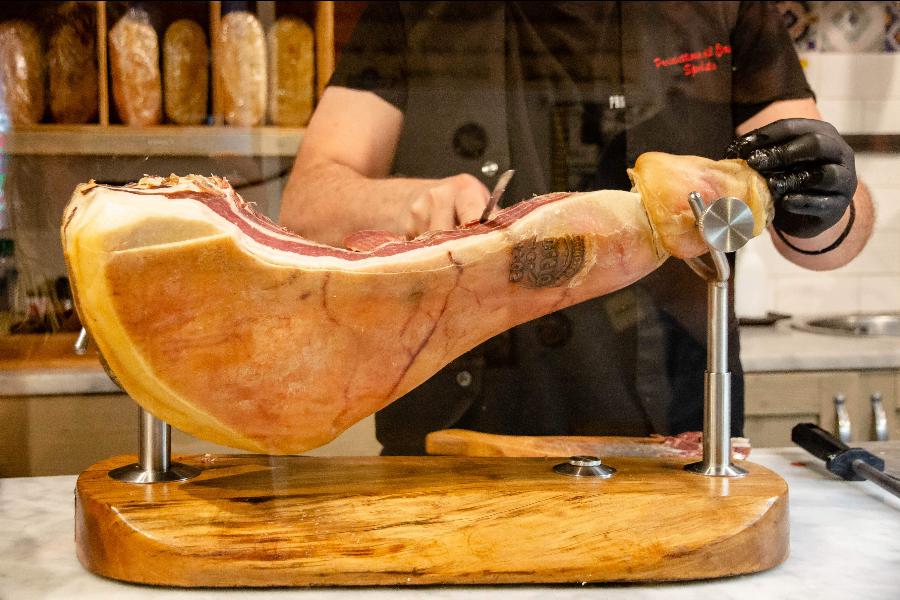
Understanding what cured meat is provides the foundation. Once you know that salt is always the starting point, you can start to see why so many different products fall into this category. From there, the key is learning the main families of curing methods, and how those lead to the diversity of flavors, textures, and traditions found all around the world.
The Two Categories of Cured Meat
The first is dry-cured, where meat is salted and then left to dry slowly until it reaches stability. This includes iconic whole muscles like prosciutto and pancetta, as well as salamis that rely on controlled fermentation and drying. The second is cured, then cooked, often with smoking involved. These are products like ham, pastrami, or mortadella, where the curing gives flavor and preservation, but cooking finishes the process.
For me, the dry-cured path has always been the most fascinating. Watching meat transform over months without ever seeing heat is something I never get tired of. But both categories are valid expressions of the craft, and they show how versatile curing has become—from ancient preservation technique to modern culinary art.
Dry-Cured (Air-Dried & Preserved)
Dry curing is where most people picture traditional European meats hanging in a cellar or cool room. The idea is simple: apply salt, sometimes with spices, and let time and air do the work. When done right, it creates intense flavor and a texture you can’t get any other way. I’ve spent years experimenting with dry curing at home, using fridges, curing chambers, and even improvised setups, and I still find the results remarkable.
If you’re interested in the step-by-step process I use, here’s a complete guide I put together on how to dry cure meat at home. In this article, though, I’ll focus on explaining the two main approaches that sit under dry curing itself.
Two Core Methods of Salt Curing
Every traditional dry cure I’ve ever come across falls into one of two methods. Each has its advantages and quirks, and I’ve used both depending on the project over time. The first is the excess saltbox method, the classic way it’s been done for centuries. The second is equilibrium curing, a more modern and precise approach that suits controlled environments and those who want repeatable results.
Excess / Saltbox Method
This is the method most people think of when they imagine curing in an old stone cellar. You surround the meat with salt and let it sit until enough moisture has been drawn out. It’s simple and highly effective, but the trade-off is that the final product can often end up saltier. The rule of thumb I was taught and still use is about one day in salt per half to one kilo of meat (it depends on how much fat and some other factors. So, a one-kilogram piece might take a day or two, while something significant like a five-kilo ham could sit buried in salt for three weeks or more.
I’ve written a full breakdown of the saltbox method here, including how I adjust for different cuts. It’s rustic and forgiving, and sometimes that’s precisely what you want. For beginners, it also provides a sense of the old-school craft—burying a slab of pork belly or beef in salt and letting time do the rest.
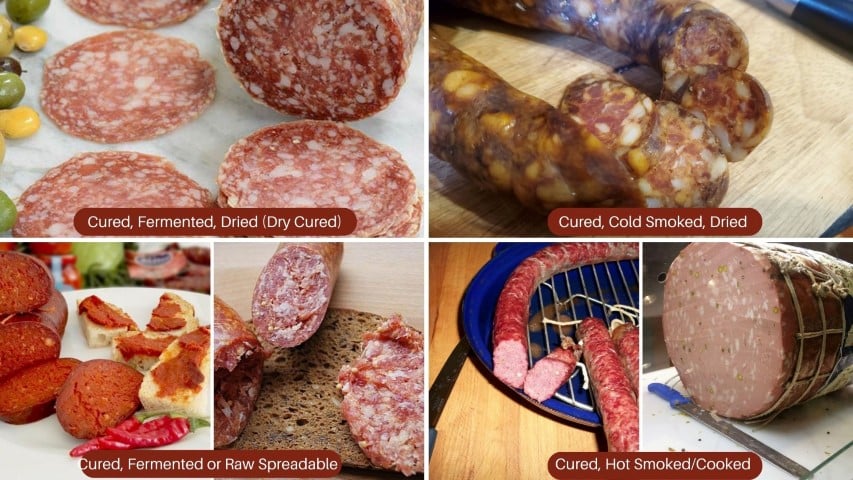
One downside I’ve experienced with excess curing is that once the salt has gone too far, you can’t bring it back. If the meat absorbs too much, you’re left with an overly salty product. You can sometimes soak or blanch to balance it, but it’s not ideal. That’s why many curers eventually explore equilibrium curing.
Equilibrium Curing
Equilibrium curing is the approach I rely on most today. Instead of guessing with time in salt, you calculate precisely how much salt the meat needs based on its weight. I usually work around 2.5–3% of the meat’s weight, depending on the cut and project. Once you know the ratio, you apply that measured salt, vacuum seal or bag it, and let diffusion do the work. Over time, the salt evenly penetrates the meat.
This method requires more patience, as the meat may sit in the cure for weeks before drying begins, but the reward is consistency. A pancetta cured this way will taste the same batch after batch. For anyone serious about charcuterie, learning this method is a game-changer. I detailed my whole process in the equilibrium curing guide, where I cover percentages, curing times, and common pitfalls.
When I teach or share with others, I usually say this: excess curing is a fantastic way to learn the tradition, but equilibrium curing is what lets you repeat success over and over. In my own curing chamber, most projects now use equilibrium percentages because I like the control and balance it gives to the final product.
Once you’ve seen how salt alone can preserve and transform meat, the next step—adding complexity with spices, fermentation, or smoke—becomes even more rewarding. Before we get there, let’s also look at the second big family of cured meats, the ones that are cured but then cooked or hot smoked.
Cooked or Hot-Smoked Cured Meats
The second major category of cured meat includes those that are salted, sometimes brined, and then cooked or hot smoked. Unlike prosciutto or salami, these products aren’t preserved only through salt and drying—they rely on heat to finish the process. That’s why they look, taste, and behave differently compared to air-dried meats. They often carry a smoky aroma, a softer texture, and they’re ready to eat immediately after cooking.
A common question I hear is whether these meats are truly “cured” or just cooked. The answer is that they are both. Salt curing or brining is the first step, but heat ensures they are fully cooked. If you’re unsure about where the line is, I explained it further in my article on whether cured meats are cooked or raw. The distinction is important because it highlights how diverse the curing craft has become.
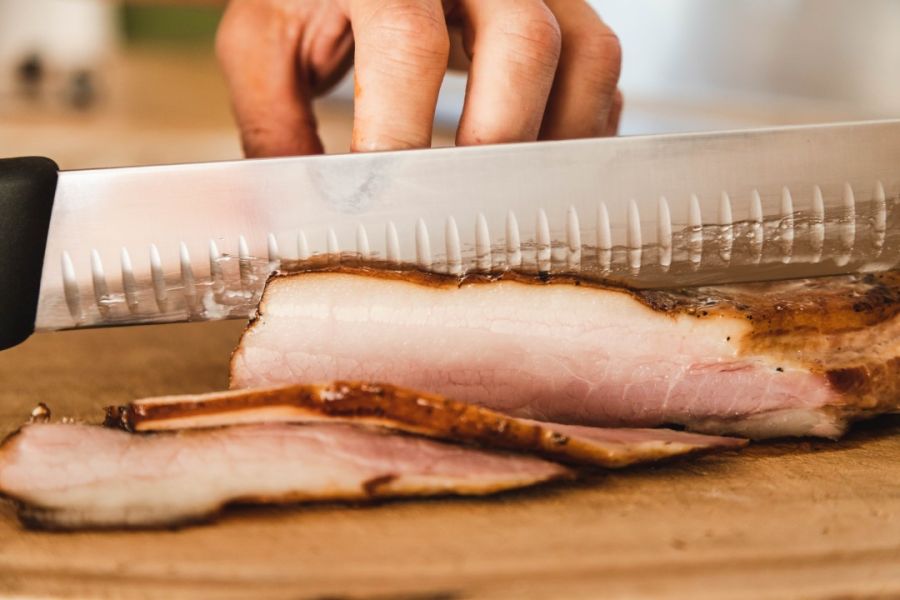
Let’s look at some well-known examples of cooked and hot-smoked cured meats. Each shows a slightly different approach, but they all share the principle of combining curing with cooking.
Ham
Ham is perhaps the best-known cured and cooked meat. Depending on the region, it may be wet-brined or dry-salted, then smoked or baked until fully cooked. Commercial hams are often mass-produced, but artisanal versions can be extraordinary. Some of the best I’ve tasted were from small smokehouses, where the balance of salt, sweetness, and smoke came together perfectly.
Pastrami
Pastrami starts with a beef cut, usually brisket, which is cured in a spiced brine and then hot-smoked. The result is a meat that’s both intensely flavored and tender. Pastrami shows how curing can be adapted to cultural traditions—in this case, Jewish delis in the United States turned it into an icon.
Mortadella & Salame Cotto
Mortadella and salame cotto represent the emulsified, cooked side of curing. Mortadella is made by finely grinding pork with spices and sometimes pistachios or truffles, then simmering it until set. Salame cotto, which I first saw at Smoking Goose in Indianapolis, is cured but then steamed, creating a unique texture compared to traditional dry salami. Both demonstrate how curing and cooking can merge into something very different from air-dried meats.
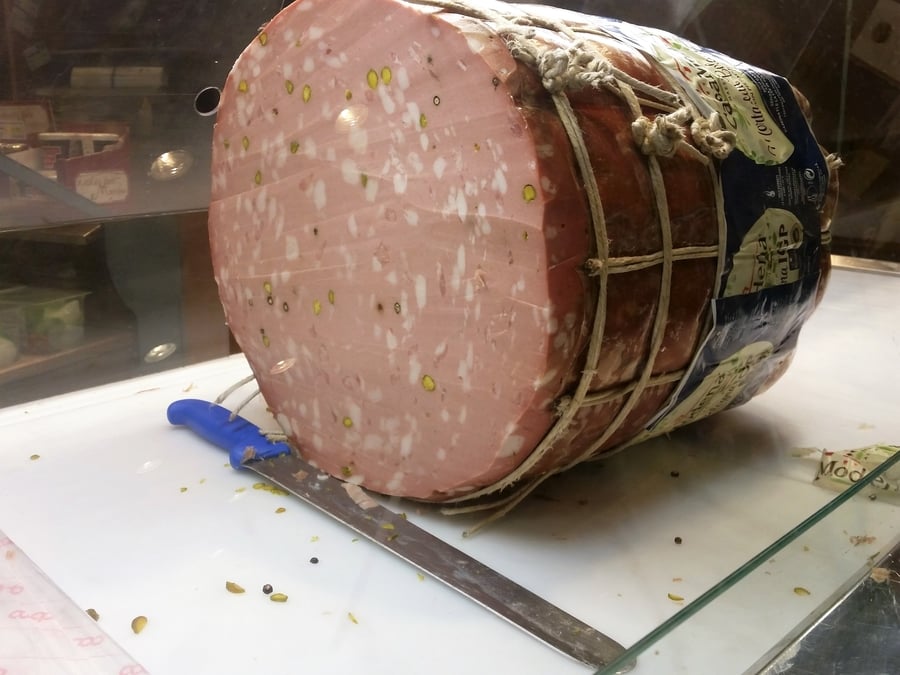
Kielbasa & Linguiça
Kielbasa from Poland and linguiça from Portugal are two sausages that rely on curing plus hot smoking or cooking. Both are often served grilled, roasted, or added to hearty dishes. kolbász, a Hungarian variation as well, is cold-smoked with simple spices.
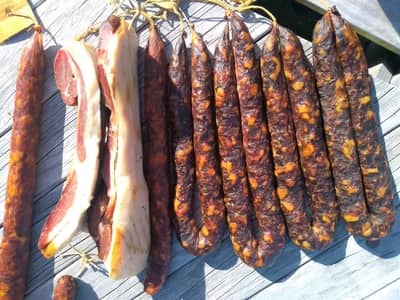
Hot Dogs & Frankfurters
Although often overlooked, hot dogs and frankfurters are also part of this family. They are emulsified sausages, cured and then cooked, frequently smoked for added flavor. While commercial versions can be filled with additives, traditional approaches use little more than meat, fat, salt, and spices. I’ve had the chance to compare artisanal frankfurters with supermarket ones, and the difference is night and day.
These examples show that the cooked and hot-smoked branch of curing is diverse. From whole muscle cuts like ham and pastrami to emulsified sausages like mortadella and hot dogs, each brings a different cultural and culinary story. They also remind us that “cured” doesn’t always mean dried and raw—it can mean cured and then cooked, ready to eat straight away.
Next, we’ll explore some of the most popular cured meats overall, from prosciutto and jamón to bresaola and chorizo. This is where categories overlap, but seeing them side by side gives a clear sense of the range and tradition within cured meats worldwide.
Popular Types of Cured Meats
Cured meats vary hugely depending on the culture, the cut of meat, and whether they’re air-dried or cooked/ hot, or warm-smoked.
European Classics
Europe is home to some of the most famous cured meats. Prosciutto from Italy, jamón from Spain, and chorizo from Spain and Portugal are known worldwide. Each region developed its own specialties based on climate and available ingredients. I still remember tasting prosciutto aged for 24 months in Parma—the sweet aroma and silky texture were unforgettable. If you can’t get authentic prosciutto, there are some solid prosciutto substitutes that work well in cooking or on a charcuterie board.
| Cured Meat | Origin | Description |
|---|---|---|
| Prosciutto di Parma | Italy | Fermented sausage seasoned with paprika and garlic. It can be dry-cured or cooked. |
| Jamón Serrano | Spain | Mountain-aged dry-cured ham, usually from white pigs. Distinct from the premium Ibérico. |
| Jamón Ibérico | Spain | From Ibérico pigs, often acorn-fed. Aged longer, with complex nutty flavor. |
| Chorizo | Spain/Portugal | Fermented sausage seasoned with paprika and garlic. Can be dry cured or cooked. |
| Bresaola | Italy | Air-dried beef, lean and delicate, sliced thin as an antipasto. |
| Capicola (Coppa) | Italy | Dry-cured upper pork neck or top of shoulder. Rich marbling and a balanced flavor, complex |
| Pancetta | Italy | Cured pork belly, often used to cook dishes like carbonara. I covered its cousin guanciale in my guide on what cured meat to use for carbonara. |
International Styles
Outside Europe, cured meats have evolved in fascinating ways. In China, lap cheong sausages are sweet and smoky. In South Africa, biltong is air-dried with spices. In Bulgaria, lukanka develops a tangy note from fermentation, similar to why salami sometimes tastes sour. Each of these reflects local taste, ingredients, and climate. I love exploring these differences because they show that curing is a global craft, not just a Mediterranean one.
| Cured Meat | Origin | Description |
|---|---|---|
| Lap Cheong | China | Sweet, cured sausage often smoked, used in stir-fries or steamed rice dishes. |
| Biltong | South Africa | Air-dried beef strips, spiced and cut thicker than jerky. |
| Lukanka | Bulgaria | Fermented sausage with tangy flavor from lactic acid bacteria. |
| Nduja | Italy (Calabria) | Cured salami spreadable , often smoked, is used in pasta or many rich dishes. |
Cooked/Hot-Smoked Cured Meats
Some of the most popular cured meats fall into the cooked branch. Ham, mortadella, kielbasa, and pastrami are staples in many cuisines. While they don’t have the exact long drying times as prosciutto or salami, they still rely on salt curing first. In America, bacon sits in a unique spot—it can be dry cured and cold smoked, hot smoked, or even air dried further. That’s why I included it in my guide to whether cured meat is keto, because bacon bridges categories depending on how it’s prepared.
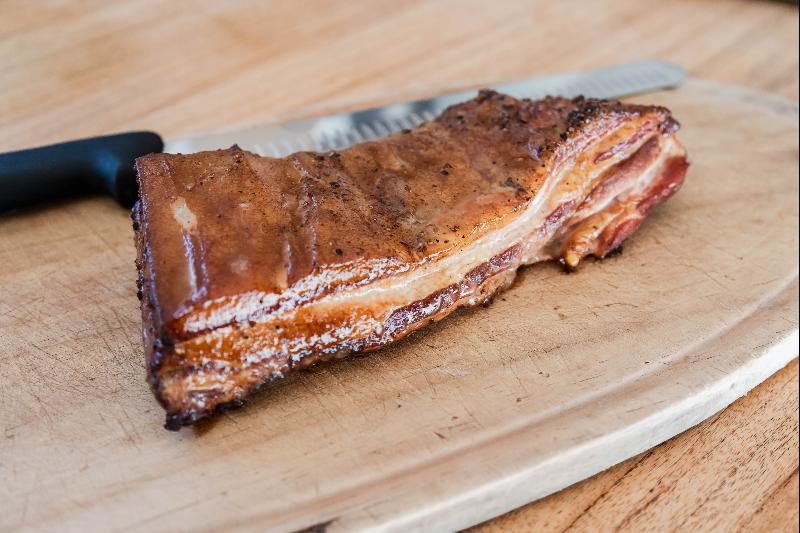
Seeing all these side by side reinforces the point: curing is a broad spectrum. From raw air-dried meats that can last for years to quick-brined and cooked sausages, the techniques span thousands of years of trial and error. And yet, they all tie back to the same principle—salt as the starting point, with variations built on top of it.
Up next, we’ll go back in time for a brief history of cured meat. Understanding where these traditions came from puts today’s products into context, from ancient preservation to modern charcuterie boards.
Natural and Synthetic Nitrates
In more recent history, another layer entered the curing craft: nitrates and nitrites. These compounds occur naturally in certain vegetables, like celery or beetroot, and they can also be added in purified forms. It is traditionally available in some forms of salt, and it is now available as an additive.
It’s essential to clarify something that often confuses people: nitrates and nitrites are not what define curing. Salt is.
I’ve explained in other articles that pink curing salt is essentially regular salt with nitrite added for specific projects. But you can absolutely cure meat with just salt, as has been done for thousands of years.
It can provide protection, speed up the curing and give the pork meat a pinkish color.
Using curing salts with nitrites is a choice, not a requirement, depending on the style of meat and your goals.
“Uncured” Packaging Explained
One confusing trend, especially in the United States, is the “uncured” label you’ll see on bacon, ham, and other products. The law there requires companies to use this label if they add natural sources of nitrates, like celery powder, rather than synthetic curing salts. The irony is that the effect is basically the same—the meat is still cured, just with a different nitrate source. In Europe, you generally won’t see this kind of labeling.
When I first saw “uncured bacon” in American stores, I was puzzled. To me, the meat was clearly cured, and the taste confirmed it. Once I looked into the regulations, it made sense from a labeling standpoint, but not from a craft perspective. This illustrates how modern laws and marketing can sometimes introduce confusion into an otherwise straightforward process.
Some researchers and consumer groups have questioned whether nitrates are needed at all, especially in long-term traditional dry curing. For me, the key is being clear about why you’re using them. If I want the characteristic pink pork color and certain flavors, or when warm smoking or long wet curing, I may add curing agent salts. If not, I stick to pure sea salt. Either way, I always keep in mind that salt does the heavy lifting.
Dry-Cured Whole Muscles
Dry-cured meats like prosciutto, pancetta, or bresaola are preserved by salt and slow drying. When stored properly, they can last months or even years. I’ve vacuum-sealed my own prosciutto and kept it in the fridge—after about three years, it began to lose quality but was still safe. Flavor and texture slowly change over time, with the meat becoming drier and sometimes a little stale. The sweet spot for most whole muscles is between six months and two years, depending on conditions.
If you’re interested in prosciutto specifically, I explained the details in my article on whether prosciutto goes bad. The short version is: it doesn’t suddenly spoil if properly cured and stored, but like all food, it has a window where it tastes best.

Cooked/Hot-Smoked Meats
Cooked or hot-smoked cured meats are another story. Because they’ve been heated, their shelf life is shorter. Think of hams, pastrami, kielbasa, or mortadella. These will last weeks in the fridge, not years, unless vacuum sealed and kept very cold. They should continually be refrigerated, even though they were cured first. I explained this further in my guide on whether cured meats need refrigeration, which clears up some of the common confusion.
In my experience, once you open a pack of sliced cooked ham or salami, you’ve got about 5–10 days before quality drops noticeably. The meat may still be edible longer, but the texture dries out quickly. It, of course, depends on the salami as well – some take days to make, others take months.

Packaging makes a difference, too. Vacuum-sealed packs of cooked cured meats can last weeks, while sliced deli packs have much shorter lives once opened. That’s why I always encourage people to think about how much they’ll realistically use, and buy or slice accordingly. Waste can be avoided with a bit of planning.
Whether it’s a whole dry-cured ham or a package of cooked ham slices, the principle remains the same: salt gives cured meats longevity, but time, air, and handling all play their roles in how long that longevity actually lasts. Knowing these differences helps you enjoy each style at its best.
Now that we’ve covered storage and shelf life, let’s turn to supporting knowledge—official references, resources, and even videos that can help deepen your understanding of cured meat beyond my own experience.
Official References & Resources
Beyond my own teaching and hands-on experience, there are excellent resources from universities and government agencies that dive into the science and food safety side of curing. When I started curing meats over 15 years ago, these were the references I leaned on to understand the technical background while I built my own chamber and learned through trial and error.
USDA & American Meat Science Association both provide technical papers and curing guides. For home-scale detail, the National Center for Home Food Preservation offers practical curing instructions. The American Meat Science Association shares deeper research on meat science, preservation, and production trends.
For international readers, Hong Kong’s Centre for Food Safety also publishes reports on curing and additives. These are valuable for understanding how different parts of the world regulate and view nitrates and curing processes.
Comparing American & European Traditions
I’ve noticed a distinct divide between American and European curing traditions. In Europe, especially Italy and Spain, whole muscles are often air-dried for many months with little more than salt and patience. In America, commercial curing tends to lean toward faster, cooked products like ham, corned beef, and pastrami. A helpful reference for this is the Pork Gateway comparison of European and American ham systems. It shows just how much environment and culture influence the result.
Video: Dry Cured Meat in Practice
To bring these concepts to life, I created a video that walks through dry-cured meats in practice. It covers both whole muscle and salami styles, showing how salt, time, and airflow transform raw cuts into something incredible.
What is the difference between dry-cured and cooked cured meats?
Dry-cured meats like prosciutto and salami rely on salt and slow drying, often lasting months or years. Cooked cured meats like ham or pastrami are salted first but then cooked or smoked, giving them shorter shelf lives.
Do all cured meats use nitrates or nitrites?
No. Traditional curing for thousands of years relied only on salt. Nitrates and nitrites are optional and often used for color, flavor, and safety in specific recipes.
How long does cured meat last once sliced?
Once sliced, cured meats lose quality faster. Dry-cured slices should be eaten within days to weeks, while cooked slices like ham are best within 5–7 days of opening.
Can cured meat be made at home?
Yes, with the right setup. A small converted fridge or curing chamber, good quality salt, and patience are enough to start. Beginners often try pancetta, coppa, or duck breast.
I’d love to hear from you — have you tried curing meat at home, or do you stick to buying cured meats from artisan producers? Leave a comment below and share your thoughts or questions.

Tom Mueller
For decades, immersed in studying, working, learning, and teaching the craft of meat curing, sharing the passion and showcasing the world of charcuterie and smoked meat. Read More
